
14-Day Trip to Historic Munich, Salzburg, Vienna, and Prague
 14 Day Tour of Munich, Salzburg, Vienna and Prague
14 Day Tour of Munich, Salzburg, Vienna and Prague
Overview
Trip Map
Itinerary
Inclusions
Reviews







14 Days 13 Nights
Best Time: Jan-Dec
Cultural Exploration
History Buffs
Embark on a thrilling 14-day journey which begins in royal Munich, with its famed Oktoberfest brewing traditions and architectural marvels. Continue to the decorus streets of Salzburg, where Mozart composed, and The Sound of Music's von Trapp family sang. Continue to Vienna, where Habsburg imperial heritage includes Viennese coffee, Klimt paintings, and Lippizaner horses, and conclude in the medieval city of Prague. Its many Gothic and Baroque splendors like the Prague Castle and Charles Bridge, all within walking distance, will captivate. Private guided tours & detailed travel directions will unlock the stories of these incomparable cities!
- Discover the beautiful city of Munich with a traditional pretzel & relax in famous beer gardens.
- Admire the Bavarian Alps from the superlative beauty of Neuschwanstein Castle
- Investigate the "salty" history of Salzburg and (re) discover the cheery brilliance of Mozart
- Wander Vienna and its historic buildings while enjoying palatial visits and vistas
- Linger in the orchards of Prague's Petřín Hill before a romp through Old Town
- Mine the silvery history of Kutná Hora and thrill at its macabre "Bone Church"
Embark on a thrilling 14-day journey which begins in royal Munich, with its famed Oktoberfest brewing traditions and architectural marvels. Continue to the decorus streets of Salzburg, where Mozart composed, and The Sound of Music's von Trapp family sang. Continue to Vienna, where Habsburg imperial heritage includes Viennese coffee, Klimt paintings, and Lippizaner horses, and conclude in the medieval city of Prague. Its many Gothic and Baroque splendors like the Prague Castle and Charles Bridge, all within walking distance, will captivate. Private guided tours & detailed travel directions will unlock the stories of these incomparable cities!
- Discover the beautiful city of Munich with a traditional pretzel & relax in famous beer gardens.
- Admire the Bavarian Alps from the superlative beauty of Neuschwanstein Castle
- Investigate the "salty" history of Salzburg and (re) discover the cheery brilliance of Mozart
- Wander Vienna and its historic buildings while enjoying palatial visits and vistas
- Linger in the orchards of Prague's Petřín Hill before a romp through Old Town
- Mine the silvery history of Kutná Hora and thrill at its macabre "Bone Church"

Old Town
Architecture

Residence Palace
Castles & Chateaux

Deutsches Museum
Museums & Galleries

Hohensalzburg Fortress
Castles & Chateaux

Old Town
Architecture

Hofburg Palace
Castles & Chateaux

Prague Castle
Castles & Chateaux

Charles Bridge
Historic Landmarks
Must see sights

Old Town
Architecture

Residence Palace
Castles & Chateaux

Deutsches Museum
Museums & Galleries

Hohensalzburg Fortress
Castles & Chateaux

Old Town
Architecture

Hofburg Palace
Castles & Chateaux

Prague Castle
Castles & Chateaux

Charles Bridge
Historic Landmarks
Starting from
$2897
per person
 Not included
Not included Secure Your Customizable Trip
Enter your details to embark on a journey that can be tailored just for you.
Start
Travelers
0 travelers
Add Room
Remove Room
Preferred Hotel Stars
Select Hotel Stars
Craft Your Own Itinerary
Select your interests and destinations for a trip plan inspired by you.
Munich, Salzburg, Vienna & Prague Trip - Map & Itinerary
Enable/Disable Map Scrolling
Click To Make Map Interactive

Munich, Salzburg, Vienna & Prague Trip Timeline
 Edit Details
Edit DetailsArrival
3 nights
Munich
Germany
Train: 1.5h
2 nights
Salzburg
Austria
Train: 2.5h
3 nights
Vienna
Austria
Train: 4.5h
5 nights
Prague
Czech Republic
Departure
Day-By-Day Itinerary of Munich, Salzburg, Vienna & Prague Trip

Day 1
Arrive Munich
Day 1
Arrive Munich



To Be Determined
Transfer from Airport
Munich has one main airport, Munich International Airport, where almost all visitors arrive. Taxis are available directly at the terminal exit, or you can arrange a private transfer for added convenience. The cheapest and fastest way to reach central Munich from is by train. The regional "S-bahn" trains delivers you from the airport train station (just follow the signs) directly to Munich's main station (München hbf) in the center of the city, from where you can easily hail a taxi that will be much less expensive than from the airport.

Day 1
Arrive Munich


Day 1
Arrive Munich




To Be Determined:
Transfer from Airport
Mid-Day/Afternoon:
Deutsches Museum
Late Afternoon/Early Evening:
Residence Palace


Day 2
Munich
Day 2
Munich



9:00 AM - 11:30 AM
Guided Walk Tour of Historic Munich
Munich contains many reminders of a long and varied history but also encompasses the modern features of a strong and vibrant city. The insights of a local help make sense of the traditions, trends, and promises of Bavaria's Capital - sometimes referred to as the city of laptops and lederhosen. On this tour, your guide will show you the highlights of Munich and point out the many hidden treasures.

Day 2
Munich



Day 3
Munich
Day 3
Munich

Early Morning to Afternoon
Excursion to Neuschwanstein Castle
An inspiration for the Disney Castles, numerous fairy tales, and countless dreamers, the Castle of Neuschwanstein is perhaps the most famous castle in the world. The eccentric Bavarian King Ludwig II created this amazing palace in the 19th century as an idyllic version of a medieval castle. You can visit by taking a guided tour from Munich or traveling independently by train and bus. In addition to enjoying spectacular views you can take a guided tour of the castle interior which is well worth the experience (but keep in mind that there a lots of steps to negotiate). If traveling independentally, be sure to book your interior tour reservations at least two days in advance.

Linderhof Palace
Stop by King Ludwig II's smallest palace on your way to Neuschwanstein and explore its delightful gardens.
Show More

Mary's Bridge
Enjoy a stunning view of the castle while suspended over a mountainous gorge.
Show More

Linderhof Palace
Stop by King Ludwig II's smallest palace on your way to Neuschwanstein and explore its delightful gardens.
Show More

Mary's Bridge
Enjoy a stunning view of the castle while suspended over a mountainous gorge.
Show More

Linderhof Palace
Stop by King Ludwig II's smallest palace on your way to Neuschwanstein and explore its delightful gardens.
Show More

Mary's Bridge
Enjoy a stunning view of the castle while suspended over a mountainous gorge.
Show More
prev
next

Day 3
Munich


Linderhof Palace
 Highlight of Excursion to Neuschwanstein Castle
Highlight of Excursion to Neuschwanstein CastleStop by King Ludwig II's smallest palace on your way to Neuschwanstein and explore its delightful gardens.
Another of the eccentric (some say mad) King Ludwig II's creations is Linderhof Palace, which with its fantastic grotto and Moorish pavilion testifies to the king's vision. The smallest of his three palaces that he built, it is the only one that he lived to see completed. The palace is in between Munich and Neuschwanstein, meaning many tours stop there along the way.
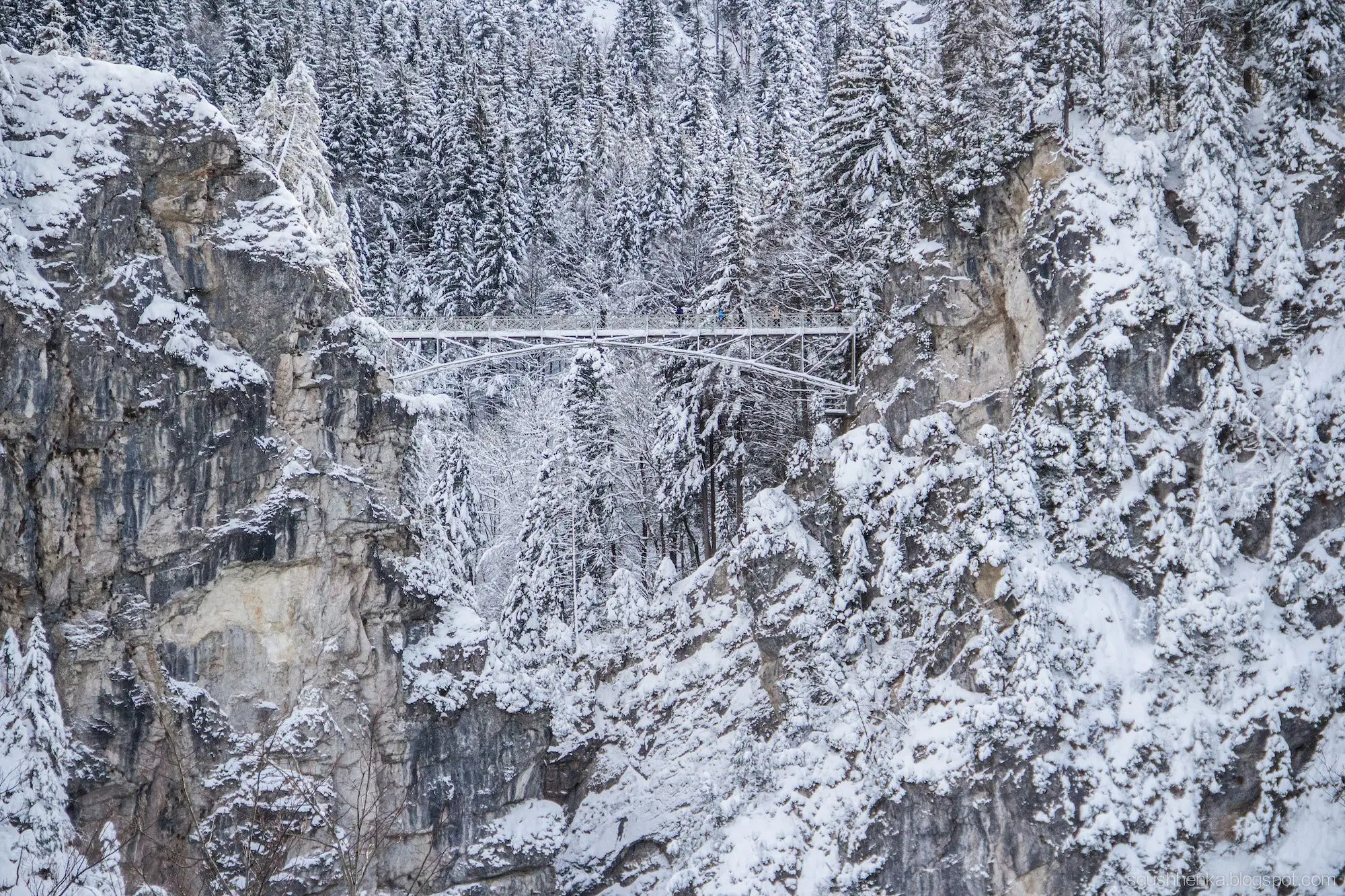
Mary's Bridge
 Highlight of Excursion to Neuschwanstein Castle
Highlight of Excursion to Neuschwanstein CastleEnjoy a stunning view of the castle while suspended over a mountainous gorge.
You definitely won't want to miss taking in the best views and photographs of Neuschwanstein from Marienbrücke (Mary's Bridge) over the dramatic Pöllat Gorge. The minibus terminal is very close at just 5 min walk away, while it's a steepish 10-15min climb on a wide and well-groomed path to get there from behind the castle. As noted above, Mary's Bridge can get a little crowded, so you might have to wait for a gap before you can fit on.

Linderhof Palace
 Highlight of Excursion to Neuschwanstein Castle
Highlight of Excursion to Neuschwanstein CastleStop by King Ludwig II's smallest palace on your way to Neuschwanstein and explore its delightful gardens.
Another of the eccentric (some say mad) King Ludwig II's creations is Linderhof Palace, which with its fantastic grotto and Moorish pavilion testifies to the king's vision. The smallest of his three palaces that he built, it is the only one that he lived to see completed. The palace is in between Munich and Neuschwanstein, meaning many tours stop there along the way.

Mary's Bridge
 Highlight of Excursion to Neuschwanstein Castle
Highlight of Excursion to Neuschwanstein CastleEnjoy a stunning view of the castle while suspended over a mountainous gorge.
You definitely won't want to miss taking in the best views and photographs of Neuschwanstein from Marienbrücke (Mary's Bridge) over the dramatic Pöllat Gorge. The minibus terminal is very close at just 5 min walk away, while it's a steepish 10-15min climb on a wide and well-groomed path to get there from behind the castle. As noted above, Mary's Bridge can get a little crowded, so you might have to wait for a gap before you can fit on.

Linderhof Palace
 Highlight of Excursion to Neuschwanstein Castle
Highlight of Excursion to Neuschwanstein CastleStop by King Ludwig II's smallest palace on your way to Neuschwanstein and explore its delightful gardens.
Another of the eccentric (some say mad) King Ludwig II's creations is Linderhof Palace, which with its fantastic grotto and Moorish pavilion testifies to the king's vision. The smallest of his three palaces that he built, it is the only one that he lived to see completed. The palace is in between Munich and Neuschwanstein, meaning many tours stop there along the way.

Mary's Bridge
 Highlight of Excursion to Neuschwanstein Castle
Highlight of Excursion to Neuschwanstein CastleEnjoy a stunning view of the castle while suspended over a mountainous gorge.
You definitely won't want to miss taking in the best views and photographs of Neuschwanstein from Marienbrücke (Mary's Bridge) over the dramatic Pöllat Gorge. The minibus terminal is very close at just 5 min walk away, while it's a steepish 10-15min climb on a wide and well-groomed path to get there from behind the castle. As noted above, Mary's Bridge can get a little crowded, so you might have to wait for a gap before you can fit on.
prev
next


Day 4
Munich to Salzburg
Day 4
Munich to Salzburg




8:30 AM
Transfer to Rail Station
Most trains depart from Müchen Hbf station, the largest station in the city. Before spending money on a transfer, be sure to check whether your hotel is within easy walking distance. Also consider that public transport is the cheapest and sometimes fastest option. If staying at a hotel, they can order a reliable taxi. Some private transfers will even help with your bags. Uber is also available for those with the app.

Day 4
Munich to Salzburg


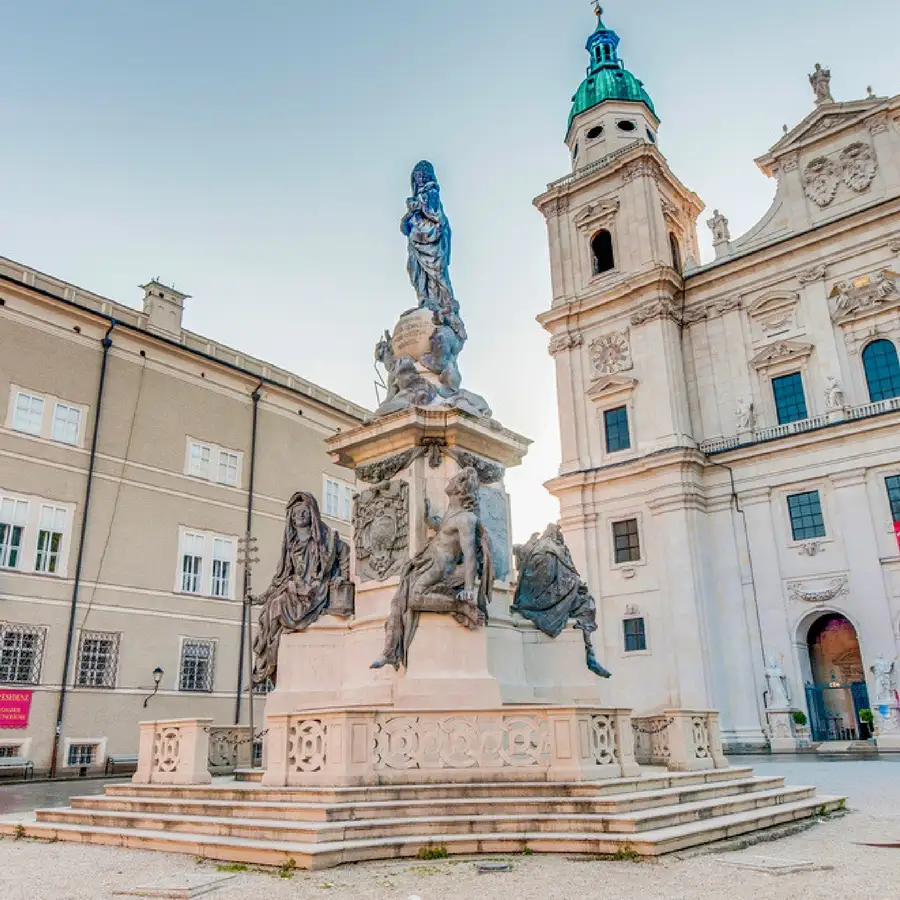
Day 5
Salzburg
Day 5
Salzburg



9:00 AM - 11:30 AM
Guided Walking Tour of Salzburg
Salzburg is simply overwhelming in all the best ways. It is alive with fascinating history, grandiose and sublime architecture fills every street and square, culture and music permeate the atmosphere, and it is surrounded by breath-taking natural scenery. This guided tour with a local will provide the context needed to bring all of this beauty into perspective, and to connect the physical city to its history, culture, and environment.

Mozartplatz
One of several grand squares in the center of Altstadt in Salzburg.
Show More

Salzburg Cathedral
Visit Salzburg's largest and most impressive church.
Show More

Mozartplatz
One of several grand squares in the center of Altstadt in Salzburg.
Show More

Salzburg Cathedral
Visit Salzburg's largest and most impressive church.
Show More

Mozartplatz
One of several grand squares in the center of Altstadt in Salzburg.
Show More

Salzburg Cathedral
Visit Salzburg's largest and most impressive church.
Show More
prev
next

Day 5
Salzburg

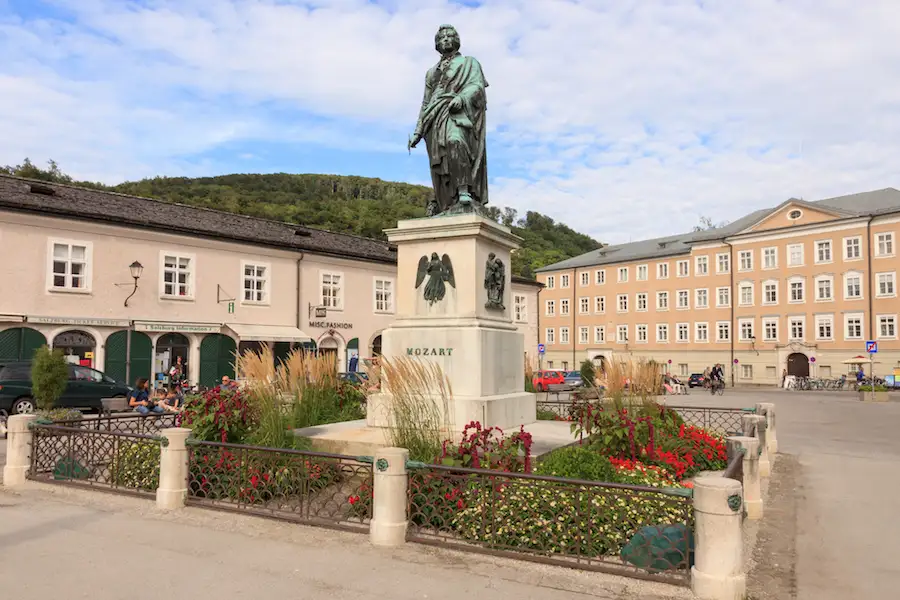
Mozartplatz
 Highlight of Guided Walking Tour of Salzburg
Highlight of Guided Walking Tour of SalzburgOne of several grand squares in the center of Altstadt in Salzburg.
One of several grand squares in the center of Altstadt in Salzburg. In the Mozartplatz you can find a statue of the famous composer.

Salzburg Cathedral
 Highlight of Guided Walking Tour of Salzburg
Highlight of Guided Walking Tour of SalzburgVisit Salzburg's largest and most impressive church.
The current cathedral was built between 1614-1628 and is a masterpiece of baroque architecture. The cathedral was largely destroyed by an Allied bomb in WWII but was restored by 1959. One of the most significant treasures in the cathedral is the Baptismal Font, which was cast in 1321 and rests on copper lions dating back to the 1100s.

Mozartplatz
 Highlight of Guided Walking Tour of Salzburg
Highlight of Guided Walking Tour of SalzburgOne of several grand squares in the center of Altstadt in Salzburg.
One of several grand squares in the center of Altstadt in Salzburg. In the Mozartplatz you can find a statue of the famous composer.

Salzburg Cathedral
 Highlight of Guided Walking Tour of Salzburg
Highlight of Guided Walking Tour of SalzburgVisit Salzburg's largest and most impressive church.
The current cathedral was built between 1614-1628 and is a masterpiece of baroque architecture. The cathedral was largely destroyed by an Allied bomb in WWII but was restored by 1959. One of the most significant treasures in the cathedral is the Baptismal Font, which was cast in 1321 and rests on copper lions dating back to the 1100s.

Mozartplatz
 Highlight of Guided Walking Tour of Salzburg
Highlight of Guided Walking Tour of SalzburgOne of several grand squares in the center of Altstadt in Salzburg.
One of several grand squares in the center of Altstadt in Salzburg. In the Mozartplatz you can find a statue of the famous composer.

Salzburg Cathedral
 Highlight of Guided Walking Tour of Salzburg
Highlight of Guided Walking Tour of SalzburgVisit Salzburg's largest and most impressive church.
The current cathedral was built between 1614-1628 and is a masterpiece of baroque architecture. The cathedral was largely destroyed by an Allied bomb in WWII but was restored by 1959. One of the most significant treasures in the cathedral is the Baptismal Font, which was cast in 1321 and rests on copper lions dating back to the 1100s.
prev
next


Day 6
Salzburg to Vienna
Day 6
Salzburg to Vienna





Early Morning to Mid-Day
Untersberg Peak
The nearly 6,000-foot high Untersberg is Salzburg's nearest Alpine Mountain, and a visit to its peak is the perfect way to experience the Alps without traveling too far. Don't worry, there's no need to bring your climbing gear. You can take a bus from Salzburg to the base of the mountain, and then take an exhilarating cable lift ride all the way to the limestone summit. There you will find a stupendous view of the Alps spread out before you, and if you feel like wandering a bit, a network of rocky trails spreads out from the summit. The Salzburg card covers both the bus ride to the lift (it's the last stop of bus line #25) and the cable car tickets!

Day 6
Salzburg to Vienna



Day 7
Vienna
Day 7
Vienna



9:00 AM - 11:30 AM
Guided Walk of the Inner City
This tour takes you back in history to explore the Vienna that stood within the old city walls. You will learn about the humble beginnings of Vienna before it became the capital of a great empire and one of the most important cities in Europe. You will discover how Vienna's early inhabitants lived and how they left their mark on the city and its beautiful Medieval, Renaissance, and Baroque architecture.

Day 7
Vienna


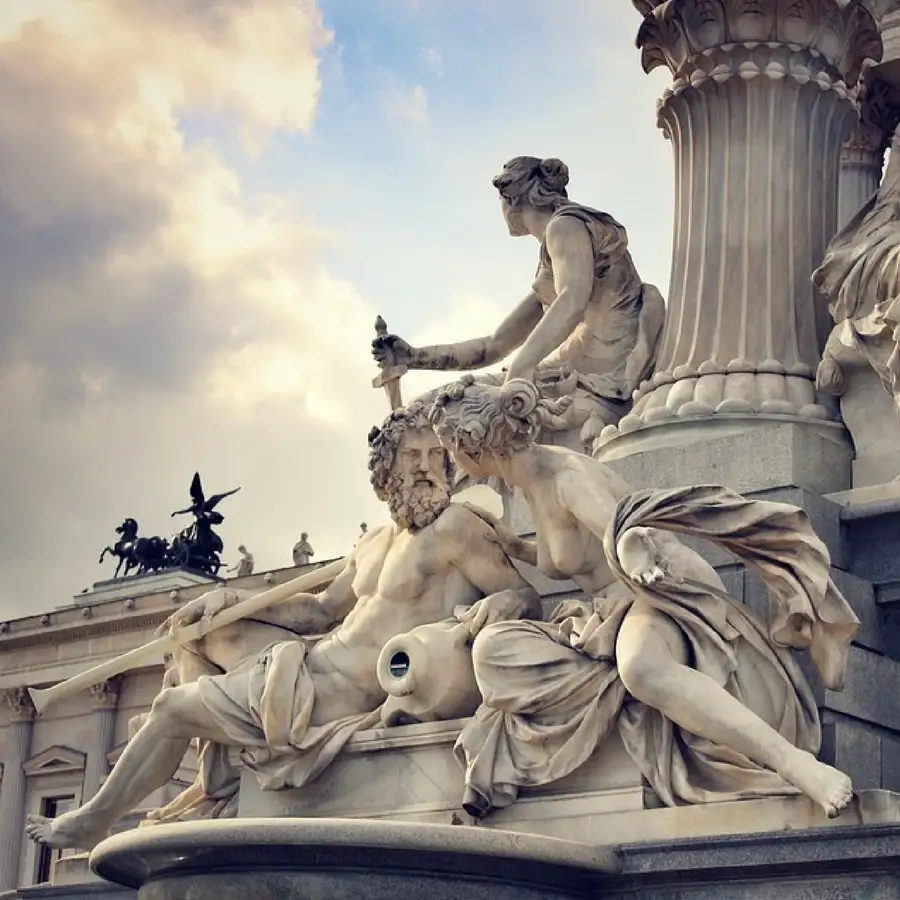
Day 8
Vienna
Day 8
Vienna


Morning to Afternoon
Schönbrunn Palace
The magnificent Baroque palace of Schönbrunn is most famously associated with Empress Maria Theresa, who lived here surrounded by 16 little archdukes and duchesses who also happened to be her children. On your tour of the palace, you will see how Maria Theresa and other past imperial residents lived. No visit is complete without a stroll in the vast gardens surrounding the palace.

Schönbrunn Zoo
Join local families enjoying one of Europe's best zoos.
Show More

Schönbrunn Gardens
Get lost in the huge imperial gardens.
Show More

Schönbrunn Zoo
Join local families enjoying one of Europe's best zoos.
Show More

Schönbrunn Gardens
Get lost in the huge imperial gardens.
Show More

Schönbrunn Zoo
Join local families enjoying one of Europe's best zoos.
Show More

Schönbrunn Gardens
Get lost in the huge imperial gardens.
Show More
prev
next

Day 8
Vienna


Schönbrunn Zoo
 Highlight of Schönbrunn Palace
Highlight of Schönbrunn PalaceJoin local families enjoying one of Europe's best zoos.
With an entrance directly connected to the Schönbrunn palace gardens, visiting the zoo can be a great addition to any trip to the palace. Founded as an imperial menagerie in 1752, it is the oldest continually operated zoo in the world, and today is home to many rare species such as giant pandas.
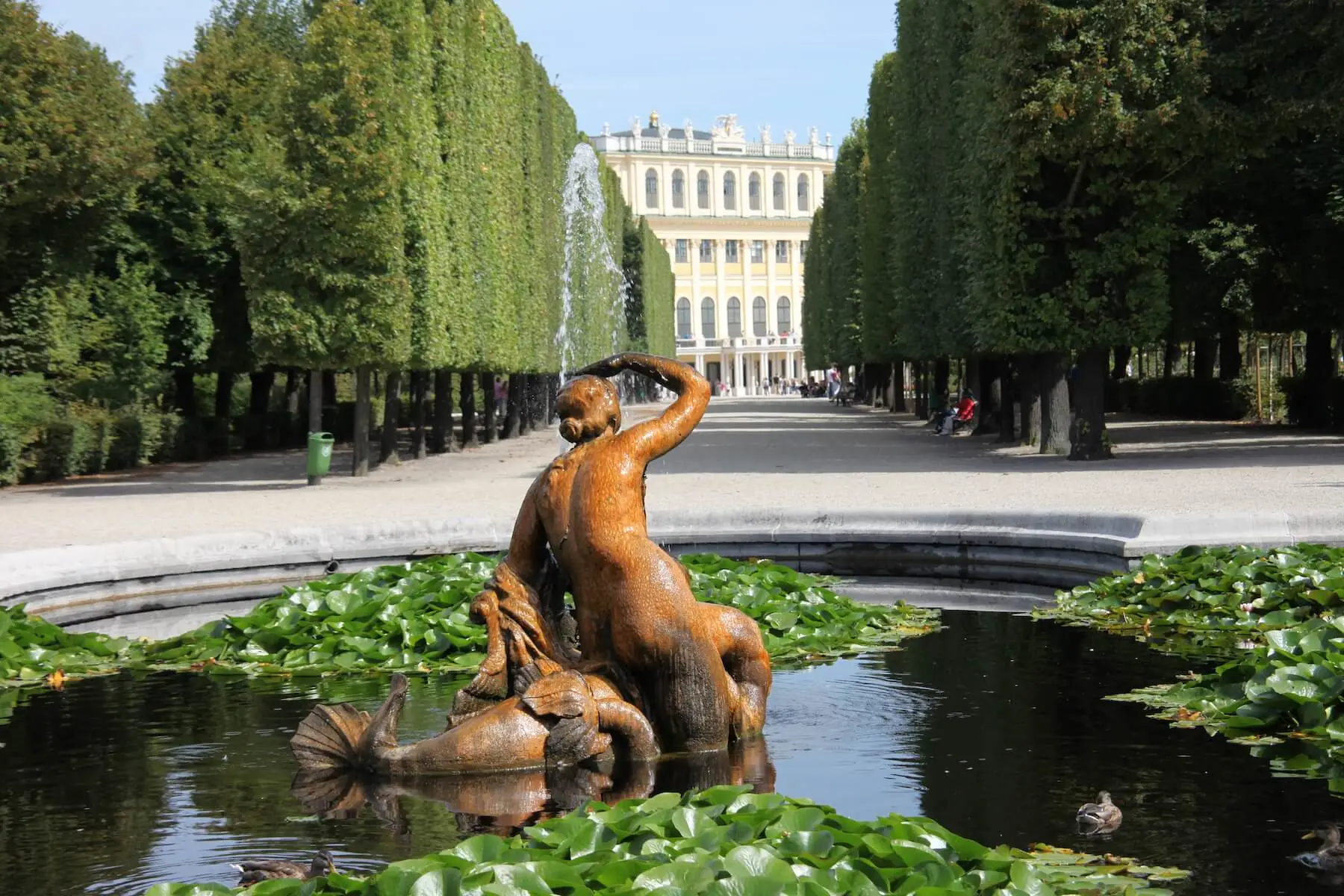
Schönbrunn Gardens
 Highlight of Schönbrunn Palace
Highlight of Schönbrunn PalaceGet lost in the huge imperial gardens.
The beautiful park is a mix of formal gardens and woodlands, and is dotted with enchanting statues & fountains, including a massive fountain of Neptune. The Gloriette pavilion sits on a rise opposite the palace and commands a wonderful view. Kids will love the labyrinth, racing to find the tower at the center of the maze.

Schönbrunn Zoo
 Highlight of Schönbrunn Palace
Highlight of Schönbrunn PalaceJoin local families enjoying one of Europe's best zoos.
With an entrance directly connected to the Schönbrunn palace gardens, visiting the zoo can be a great addition to any trip to the palace. Founded as an imperial menagerie in 1752, it is the oldest continually operated zoo in the world, and today is home to many rare species such as giant pandas.

Schönbrunn Gardens
 Highlight of Schönbrunn Palace
Highlight of Schönbrunn PalaceGet lost in the huge imperial gardens.
The beautiful park is a mix of formal gardens and woodlands, and is dotted with enchanting statues & fountains, including a massive fountain of Neptune. The Gloriette pavilion sits on a rise opposite the palace and commands a wonderful view. Kids will love the labyrinth, racing to find the tower at the center of the maze.

Schönbrunn Zoo
 Highlight of Schönbrunn Palace
Highlight of Schönbrunn PalaceJoin local families enjoying one of Europe's best zoos.
With an entrance directly connected to the Schönbrunn palace gardens, visiting the zoo can be a great addition to any trip to the palace. Founded as an imperial menagerie in 1752, it is the oldest continually operated zoo in the world, and today is home to many rare species such as giant pandas.

Schönbrunn Gardens
 Highlight of Schönbrunn Palace
Highlight of Schönbrunn PalaceGet lost in the huge imperial gardens.
The beautiful park is a mix of formal gardens and woodlands, and is dotted with enchanting statues & fountains, including a massive fountain of Neptune. The Gloriette pavilion sits on a rise opposite the palace and commands a wonderful view. Kids will love the labyrinth, racing to find the tower at the center of the maze.
prev
next


Day 9
Vienna to Prague
Day 9
Vienna to Prague





Morning/Mid-Day
Karlskirche & Belvedere Palace
Two of Vienna's greatest architectural treasures lie just beyond the Ring Street - the Belvedere Palace and the Karlskirche (St. Charles's Church). Often missed by visitors, these Baroque wonders represent Austria at the peak of its prestige and power and deserve to be on every visitor's list.

Belvedere Palace
Stroll the Belvedere's gardens, and venture inside the palace for a "Kiss".
Show More

Karlskirche
Many argue that this baroque church is as beautiful as St. Peter's - see it and decide for yourself.
Show More

Belvedere Palace
Stroll the Belvedere's gardens, and venture inside the palace for a "Kiss".
Show More

Karlskirche
Many argue that this baroque church is as beautiful as St. Peter's - see it and decide for yourself.
Show More

Belvedere Palace
Stroll the Belvedere's gardens, and venture inside the palace for a "Kiss".
Show More

Karlskirche
Many argue that this baroque church is as beautiful as St. Peter's - see it and decide for yourself.
Show More
prev
next

Day 9
Vienna to Prague


Belvedere Palace
 Highlight of Karlskirche & Belvedere Palace
Highlight of Karlskirche & Belvedere PalaceStroll the Belvedere's gardens, and venture inside the palace for a "Kiss".
Two Baraque palaces are connected by a French-style, three-level garden which features delightful fountains. Originally built as a summer residence of Prince Eugene, it now houses the Belvedere Museum where you will find Gustav Klimt's most famous work - The Kiss.

Karlskirche
 Highlight of Karlskirche & Belvedere Palace
Highlight of Karlskirche & Belvedere PalaceMany argue that this baroque church is as beautiful as St. Peter's - see it and decide for yourself.
Built between 1716-1737, Emperor Charles VI intended the church to be a thanksgiving for the end of a plague epidemic and dedicated the church to St. Charles Borromeo, who is revered for his care of plague victims. St. Charles was also his namesake, meaning that the church's name evokes the emperor's memory as much as the saint's, which was no accident. Indeed, the two columns in front of the church are meant to represent imperial power.

Belvedere Palace
 Highlight of Karlskirche & Belvedere Palace
Highlight of Karlskirche & Belvedere PalaceStroll the Belvedere's gardens, and venture inside the palace for a "Kiss".
Two Baraque palaces are connected by a French-style, three-level garden which features delightful fountains. Originally built as a summer residence of Prince Eugene, it now houses the Belvedere Museum where you will find Gustav Klimt's most famous work - The Kiss.

Karlskirche
 Highlight of Karlskirche & Belvedere Palace
Highlight of Karlskirche & Belvedere PalaceMany argue that this baroque church is as beautiful as St. Peter's - see it and decide for yourself.
Built between 1716-1737, Emperor Charles VI intended the church to be a thanksgiving for the end of a plague epidemic and dedicated the church to St. Charles Borromeo, who is revered for his care of plague victims. St. Charles was also his namesake, meaning that the church's name evokes the emperor's memory as much as the saint's, which was no accident. Indeed, the two columns in front of the church are meant to represent imperial power.

Belvedere Palace
 Highlight of Karlskirche & Belvedere Palace
Highlight of Karlskirche & Belvedere PalaceStroll the Belvedere's gardens, and venture inside the palace for a "Kiss".
Two Baraque palaces are connected by a French-style, three-level garden which features delightful fountains. Originally built as a summer residence of Prince Eugene, it now houses the Belvedere Museum where you will find Gustav Klimt's most famous work - The Kiss.

Karlskirche
 Highlight of Karlskirche & Belvedere Palace
Highlight of Karlskirche & Belvedere PalaceMany argue that this baroque church is as beautiful as St. Peter's - see it and decide for yourself.
Built between 1716-1737, Emperor Charles VI intended the church to be a thanksgiving for the end of a plague epidemic and dedicated the church to St. Charles Borromeo, who is revered for his care of plague victims. St. Charles was also his namesake, meaning that the church's name evokes the emperor's memory as much as the saint's, which was no accident. Indeed, the two columns in front of the church are meant to represent imperial power.
prev
next


Day 10
Prague
Day 10
Prague



9:00 AM - 12:30 PM
Royal Route Guided Tour
On this charming guided walk, you will explore the Prague Castle, the largest castle complex in all of Europe. To reach the castle you will trace the Royal Coronation Route and cross the Charles Bridge, whose “speaking stones” reveal the amazing and often cruel history that occurred there. Your tour guide will then take you either through the castle courtyards and into the dramatic St. Vitus Cathedral in the center of the castle complex, or through the upper part of the castle district around the oversized palaces of the old Catholic nobility and the top of the Castle Steps for incomparable views over the red rooftops of the Little Quarter.

Charles Bridge
Cross the river dividing Prague's most historic neighborhoods, and experience one of Europe's most iconic landmarks.
Show More

Maltese Square & Lennon Wall
See a historic wall that has been covered in John Lennon-inspired graffiti since Communist days.
Show More

Prague Castle
Prague Castle is one of the main attractions in Prague and is also the largest castle complex in the world.
Show More

Charles Bridge
Cross the river dividing Prague's most historic neighborhoods, and experience one of Europe's most iconic landmarks.
Show More

Maltese Square & Lennon Wall
See a historic wall that has been covered in John Lennon-inspired graffiti since Communist days.
Show More

Prague Castle
Prague Castle is one of the main attractions in Prague and is also the largest castle complex in the world.
Show More

Charles Bridge
Cross the river dividing Prague's most historic neighborhoods, and experience one of Europe's most iconic landmarks.
Show More
prev
next

Day 10
Prague

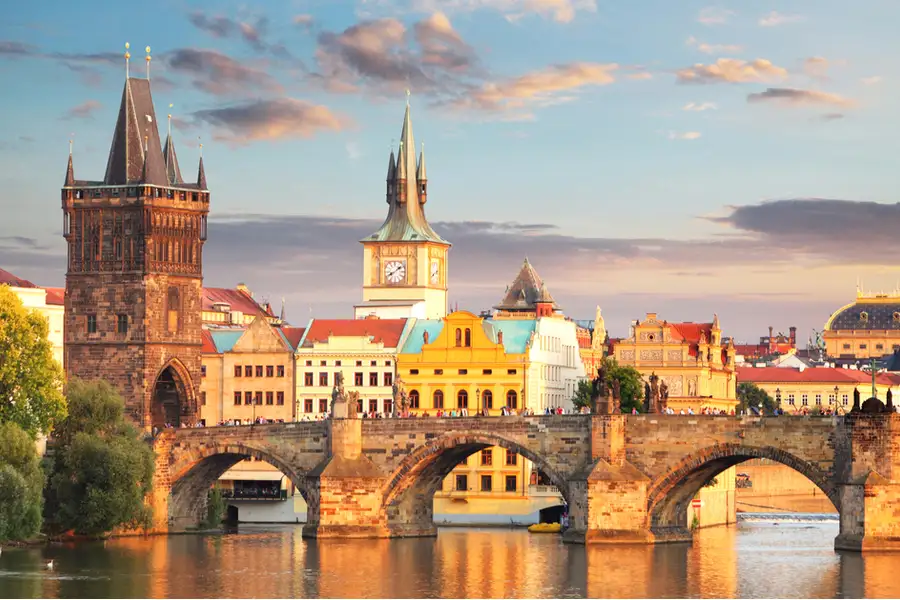
Charles Bridge
 Highlight of Royal Route Guided Tour
Highlight of Royal Route Guided TourCross the river dividing Prague's most historic neighborhoods, and experience one of Europe's most iconic landmarks.
Bridge construction began in 1357 under King Charles IV (hence the name), and it was the only bridge across the Vltava River until 1841. 30 baroque statues of saints line the bridge, and it is filled with street artists and entertainers. Not to be missed.

Maltese Square & Lennon Wall
 Highlight of Royal Route Guided Tour
Highlight of Royal Route Guided TourSee a historic wall that has been covered in John Lennon-inspired graffiti since Communist days.
The wall has been covered in graffiti since the 1960s, and during Communism anti-regime sentiment was common. John Lennon's assassination inspired grafitti reflecting his song, Imagine, which earned the wall its current moniker. It is now a favorite gathering place for tourists, and musicians sometimes congregate there as well. Just around the corner is the Maltese Square, which is one of Prague's more quaint and relaxed public spaces, despite being just off the main tourist route.

Prague Castle
 Highlight of Royal Route Guided Tour
Highlight of Royal Route Guided TourPrague Castle is one of the main attractions in Prague and is also the largest castle complex in the world.
The Prague Castle is the largest castle complex in the world with structures dating back to the 9th century. The St Vitus Cathedral and Basilica of St George can be found within the castle walls. The Prague Castle also includes several gardens, palaces, and a monastery. This castle was the seat of power for the Kings of Bohemia, Holy Roman Emperors, and presidents of former Czechoslovakia. Prague Castle is a UNESCO world heritage site and is one of the most visited places in the country.

Charles Bridge
 Highlight of Royal Route Guided Tour
Highlight of Royal Route Guided TourCross the river dividing Prague's most historic neighborhoods, and experience one of Europe's most iconic landmarks.
Bridge construction began in 1357 under King Charles IV (hence the name), and it was the only bridge across the Vltava River until 1841. 30 baroque statues of saints line the bridge, and it is filled with street artists and entertainers. Not to be missed.

Maltese Square & Lennon Wall
 Highlight of Royal Route Guided Tour
Highlight of Royal Route Guided TourSee a historic wall that has been covered in John Lennon-inspired graffiti since Communist days.
The wall has been covered in graffiti since the 1960s, and during Communism anti-regime sentiment was common. John Lennon's assassination inspired grafitti reflecting his song, Imagine, which earned the wall its current moniker. It is now a favorite gathering place for tourists, and musicians sometimes congregate there as well. Just around the corner is the Maltese Square, which is one of Prague's more quaint and relaxed public spaces, despite being just off the main tourist route.

Prague Castle
 Highlight of Royal Route Guided Tour
Highlight of Royal Route Guided TourPrague Castle is one of the main attractions in Prague and is also the largest castle complex in the world.
The Prague Castle is the largest castle complex in the world with structures dating back to the 9th century. The St Vitus Cathedral and Basilica of St George can be found within the castle walls. The Prague Castle also includes several gardens, palaces, and a monastery. This castle was the seat of power for the Kings of Bohemia, Holy Roman Emperors, and presidents of former Czechoslovakia. Prague Castle is a UNESCO world heritage site and is one of the most visited places in the country.

Charles Bridge
 Highlight of Royal Route Guided Tour
Highlight of Royal Route Guided TourCross the river dividing Prague's most historic neighborhoods, and experience one of Europe's most iconic landmarks.
Bridge construction began in 1357 under King Charles IV (hence the name), and it was the only bridge across the Vltava River until 1841. 30 baroque statues of saints line the bridge, and it is filled with street artists and entertainers. Not to be missed.
prev
next

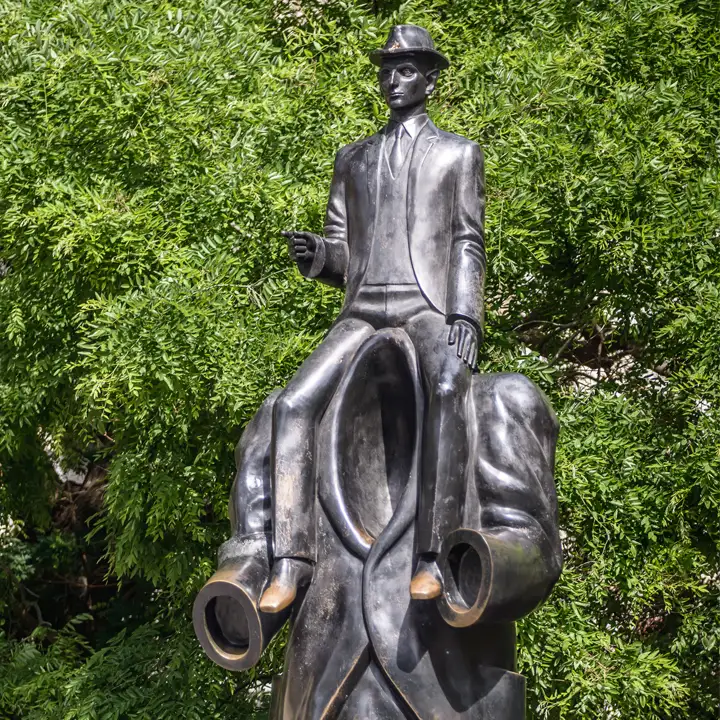
Day 11
Prague
Day 11
Prague



Morning/Mid-Day
Jewish Quarter
Jews have lived in Prague since its beginnings in the 10th century and have endowed it with a rich heritage. The ghetto was created in the 12th century, as Jews were forced to live separately from Christians. Despite persecution, the community prospered, but sadly, only a small minority survived the Nazi occupation. A lasting legacy remains, including synagogues, architecture, and a fascinating cemetery.

Spanish Synagogue
Discover the synagogue considered by many to be Prague's most beautiful.
Show More

Old-New Synagogue
See the oldest surviving synagogue in Europe and also one of Prague's earliest Gothic buildings.
Show More

Old Jewish Cemetery
Take an unforgettable visit to one of Europe's largest medieval Jewish cemeteries.
Show More

Spanish Synagogue
Discover the synagogue considered by many to be Prague's most beautiful.
Show More

Old-New Synagogue
See the oldest surviving synagogue in Europe and also one of Prague's earliest Gothic buildings.
Show More

Old Jewish Cemetery
Take an unforgettable visit to one of Europe's largest medieval Jewish cemeteries.
Show More

Spanish Synagogue
Discover the synagogue considered by many to be Prague's most beautiful.
Show More
prev
next

Day 11
Prague


Spanish Synagogue
 Highlight of Jewish Quarter
Highlight of Jewish QuarterDiscover the synagogue considered by many to be Prague's most beautiful.
Completed in 1868, the Spanish Synagogue is the newest synagogue in Prague's Jewish Quarter, but happens to be built on the site of the former Oldest Synagogue in Prague. It is built in a stunning Spanish Moorish style as a symbol of the flowering of the Jewish culture which occurred under Muslim rule on the Iberian Peninsula.

Old-New Synagogue
 Highlight of Jewish Quarter
Highlight of Jewish QuarterSee the oldest surviving synagogue in Europe and also one of Prague's earliest Gothic buildings.
When built it was Prague’s newest synagogue, but over time became its oldest – hence the “Old-New”. A beautiful ark holds the Torah and legend says its attic is the hiding place of the legendary clay Golem.

Old Jewish Cemetery
 Highlight of Jewish Quarter
Highlight of Jewish QuarterTake an unforgettable visit to one of Europe's largest medieval Jewish cemeteries.
As the Jewish Ghetto was quite cramped, there was no room to expand the cemetery. Unable to acquire further land, and not wishing to dishonor ancestors through the demolition of existing graves, Prague's Jews buried their loved ones in multiple levels. Gravestones are packed in tightly and in some areas the burials reach 12 layers!

Spanish Synagogue
 Highlight of Jewish Quarter
Highlight of Jewish QuarterDiscover the synagogue considered by many to be Prague's most beautiful.
Completed in 1868, the Spanish Synagogue is the newest synagogue in Prague's Jewish Quarter, but happens to be built on the site of the former Oldest Synagogue in Prague. It is built in a stunning Spanish Moorish style as a symbol of the flowering of the Jewish culture which occurred under Muslim rule on the Iberian Peninsula.

Old-New Synagogue
 Highlight of Jewish Quarter
Highlight of Jewish QuarterSee the oldest surviving synagogue in Europe and also one of Prague's earliest Gothic buildings.
When built it was Prague’s newest synagogue, but over time became its oldest – hence the “Old-New”. A beautiful ark holds the Torah and legend says its attic is the hiding place of the legendary clay Golem.

Old Jewish Cemetery
 Highlight of Jewish Quarter
Highlight of Jewish QuarterTake an unforgettable visit to one of Europe's largest medieval Jewish cemeteries.
As the Jewish Ghetto was quite cramped, there was no room to expand the cemetery. Unable to acquire further land, and not wishing to dishonor ancestors through the demolition of existing graves, Prague's Jews buried their loved ones in multiple levels. Gravestones are packed in tightly and in some areas the burials reach 12 layers!

Spanish Synagogue
 Highlight of Jewish Quarter
Highlight of Jewish QuarterDiscover the synagogue considered by many to be Prague's most beautiful.
Completed in 1868, the Spanish Synagogue is the newest synagogue in Prague's Jewish Quarter, but happens to be built on the site of the former Oldest Synagogue in Prague. It is built in a stunning Spanish Moorish style as a symbol of the flowering of the Jewish culture which occurred under Muslim rule on the Iberian Peninsula.
prev
next

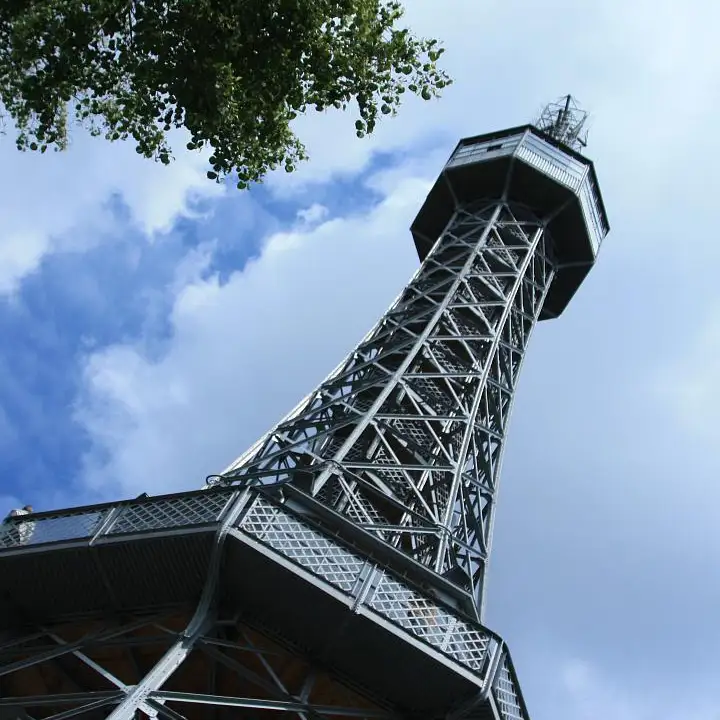
Day 12
Prague
Day 12
Prague



Morning/Mid-Day
Petřín Park
Petřin Park is Prague's most prominent park, as it is located on the side of a large hill overlooking the city. The park is filled with cherry orchards, beautiful forests, and lawns, and is crisscrossed by numerous paths as well as the medieval Hunger Wall built by Emperor Charles IV. At the top of the park is an Eiffel Tower-like observation tower which provides an unobstructed view of the city.

Petřín Mirror Labyrinth
Get delightfully lost in a 19th-century, mirrored labyrinth.
Show More

Petřín Funicular Railway
Ride an incline railway to the top of the wooded Petřín Hill to discover forest paths and beautiful city views.
Show More

Petřín Observatory Tower
Ascend the Czech version of the Eiffel Tower for an astounding 360-degree view.
Show More

Petřín Mirror Labyrinth
Get delightfully lost in a 19th-century, mirrored labyrinth.
Show More

Petřín Funicular Railway
Ride an incline railway to the top of the wooded Petřín Hill to discover forest paths and beautiful city views.
Show More

Petřín Observatory Tower
Ascend the Czech version of the Eiffel Tower for an astounding 360-degree view.
Show More

Petřín Mirror Labyrinth
Get delightfully lost in a 19th-century, mirrored labyrinth.
Show More
prev
next

Day 12
Prague


Petřín Mirror Labyrinth
 Highlight of Petřín Park
Highlight of Petřín ParkGet delightfully lost in a 19th-century, mirrored labyrinth.
This maze of mirrors was created for an 1891 Exhibition, and it was so popular that it is still open today. It is great fun for kids and adults, especially the trick mirrors. There is also a mural showing a battle which took place on the Charles Bridge in 1648.
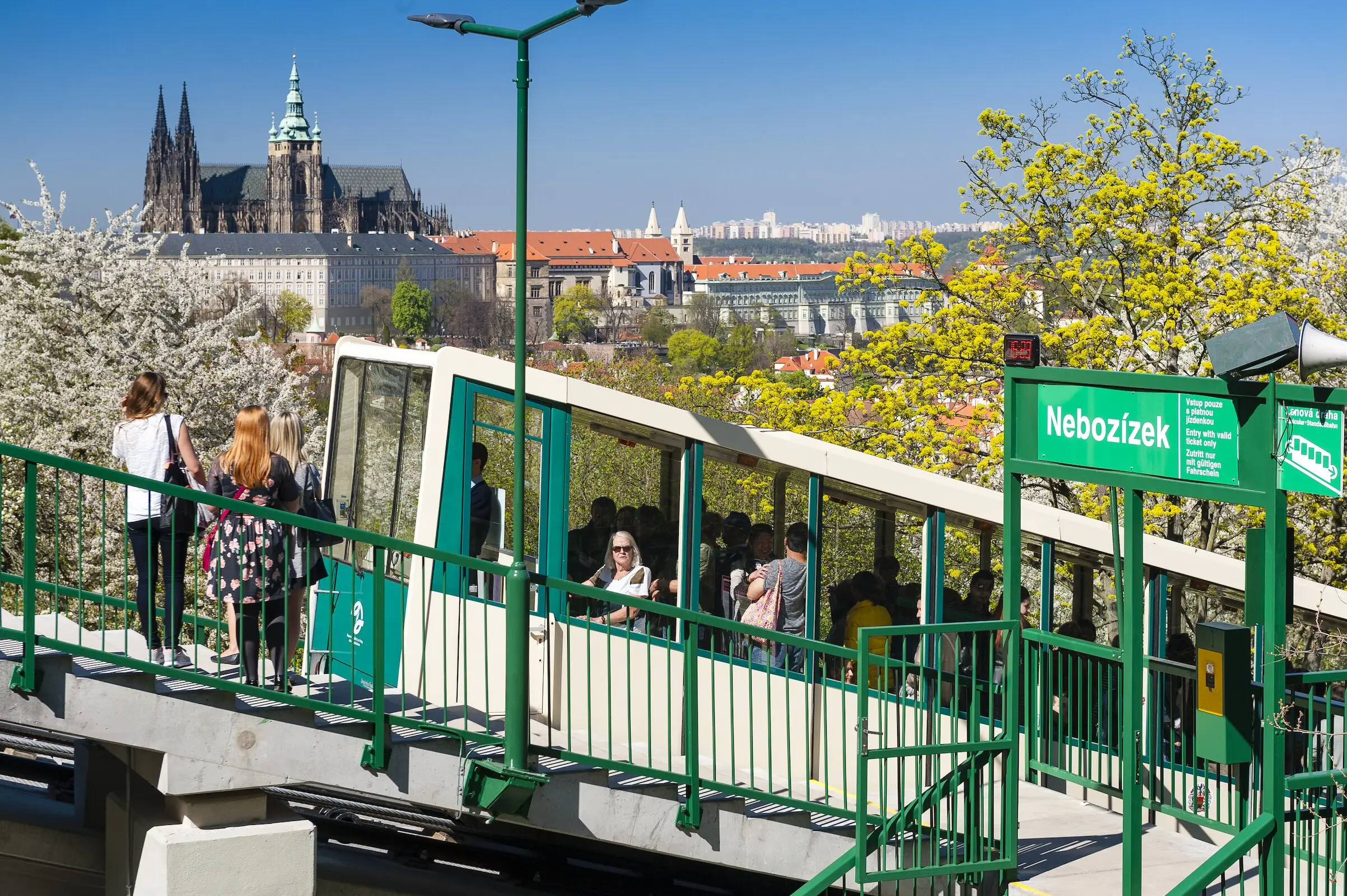
Petřín Funicular Railway
 Highlight of Petřín Park
Highlight of Petřín ParkRide an incline railway to the top of the wooded Petřín Hill to discover forest paths and beautiful city views.
This inclined railway takes visitors to the top of Petřín Hill, where they can ascend the Observation Tower or take a walk through the beautiful forest park overlooking Prague. Riders can also get off at the middle station of the railway and visit one of several restaurants overlooking the city.

Petřín Observatory Tower
 Highlight of Petřín Park
Highlight of Petřín ParkAscend the Czech version of the Eiffel Tower for an astounding 360-degree view.
Petřín Observatory Tower is a cast iron observation tower, built in 1891, that resembles the Eiffel Tower in Paris. Although this structure is only 64m tall, because it is built on a hill it is technically higher than the Eiffel Tower. Visitors enjoy a panoramic view of not only the city center, but also the suburbs and countryside surrounding Prague.

Petřín Mirror Labyrinth
 Highlight of Petřín Park
Highlight of Petřín ParkGet delightfully lost in a 19th-century, mirrored labyrinth.
This maze of mirrors was created for an 1891 Exhibition, and it was so popular that it is still open today. It is great fun for kids and adults, especially the trick mirrors. There is also a mural showing a battle which took place on the Charles Bridge in 1648.

Petřín Funicular Railway
 Highlight of Petřín Park
Highlight of Petřín ParkRide an incline railway to the top of the wooded Petřín Hill to discover forest paths and beautiful city views.
This inclined railway takes visitors to the top of Petřín Hill, where they can ascend the Observation Tower or take a walk through the beautiful forest park overlooking Prague. Riders can also get off at the middle station of the railway and visit one of several restaurants overlooking the city.

Petřín Observatory Tower
 Highlight of Petřín Park
Highlight of Petřín ParkAscend the Czech version of the Eiffel Tower for an astounding 360-degree view.
Petřín Observatory Tower is a cast iron observation tower, built in 1891, that resembles the Eiffel Tower in Paris. Although this structure is only 64m tall, because it is built on a hill it is technically higher than the Eiffel Tower. Visitors enjoy a panoramic view of not only the city center, but also the suburbs and countryside surrounding Prague.

Petřín Mirror Labyrinth
 Highlight of Petřín Park
Highlight of Petřín ParkGet delightfully lost in a 19th-century, mirrored labyrinth.
This maze of mirrors was created for an 1891 Exhibition, and it was so popular that it is still open today. It is great fun for kids and adults, especially the trick mirrors. There is also a mural showing a battle which took place on the Charles Bridge in 1648.
prev
next


Day 13
Prague
Day 13
Prague

8:30 AM - 4:30 PM
Guided trip to Kutná Hora
On this full-day guided excursion, you will discover the charming Bohemian town of Kutná Hora. Due to nearby silver mines, Kutná Hora was rich and powerful during the Middle Ages. It was even declared a Royal town, meaning that the Bohemian King directly controlled the town. The town spent much of its wealth on beautiful buildings, many of which still exist today, and which have earned the town the status of a UNESCO World Cultural site.

Sedlec Ossuary
Confront your own mortality in the crypt of a small Gothic church decorated with garlands of human skulls, plus a bone chandelier & chalices.
Show More

Sedlec Ossuary
Confront your own mortality in the crypt of a small Gothic church decorated with garlands of human skulls, plus a bone chandelier & chalices.
Show More

Sedlec Ossuary
Confront your own mortality in the crypt of a small Gothic church decorated with garlands of human skulls, plus a bone chandelier & chalices.
Show More

Sedlec Ossuary
Confront your own mortality in the crypt of a small Gothic church decorated with garlands of human skulls, plus a bone chandelier & chalices.
Show More

Sedlec Ossuary
Confront your own mortality in the crypt of a small Gothic church decorated with garlands of human skulls, plus a bone chandelier & chalices.
Show More
prev
next

Day 13
Prague


Sedlec Ossuary
 Highlight of Guided trip to Kutná Hora
Highlight of Guided trip to Kutná HoraConfront your own mortality in the crypt of a small Gothic church decorated with garlands of human skulls, plus a bone chandelier & chalices.
As macabre as it might appear, one cannot help but admire the imaginative ways in which thousands of human bones have been put to decorative use. There's everything from huge pyramids of skulls, to a chandelier to an aristocratic coat of arms composed of the remains of those who sought their final resting place in Sedlec. It’s a breath-taking reminder of the medieval practice of reflecting on mortality, summed up in the Latin expression ‘Memento mori’ or ‘remember you must die’.

Sedlec Ossuary
 Highlight of Guided trip to Kutná Hora
Highlight of Guided trip to Kutná HoraConfront your own mortality in the crypt of a small Gothic church decorated with garlands of human skulls, plus a bone chandelier & chalices.
As macabre as it might appear, one cannot help but admire the imaginative ways in which thousands of human bones have been put to decorative use. There's everything from huge pyramids of skulls, to a chandelier to an aristocratic coat of arms composed of the remains of those who sought their final resting place in Sedlec. It’s a breath-taking reminder of the medieval practice of reflecting on mortality, summed up in the Latin expression ‘Memento mori’ or ‘remember you must die’.

Sedlec Ossuary
 Highlight of Guided trip to Kutná Hora
Highlight of Guided trip to Kutná HoraConfront your own mortality in the crypt of a small Gothic church decorated with garlands of human skulls, plus a bone chandelier & chalices.
As macabre as it might appear, one cannot help but admire the imaginative ways in which thousands of human bones have been put to decorative use. There's everything from huge pyramids of skulls, to a chandelier to an aristocratic coat of arms composed of the remains of those who sought their final resting place in Sedlec. It’s a breath-taking reminder of the medieval practice of reflecting on mortality, summed up in the Latin expression ‘Memento mori’ or ‘remember you must die’.

Sedlec Ossuary
 Highlight of Guided trip to Kutná Hora
Highlight of Guided trip to Kutná HoraConfront your own mortality in the crypt of a small Gothic church decorated with garlands of human skulls, plus a bone chandelier & chalices.
As macabre as it might appear, one cannot help but admire the imaginative ways in which thousands of human bones have been put to decorative use. There's everything from huge pyramids of skulls, to a chandelier to an aristocratic coat of arms composed of the remains of those who sought their final resting place in Sedlec. It’s a breath-taking reminder of the medieval practice of reflecting on mortality, summed up in the Latin expression ‘Memento mori’ or ‘remember you must die’.

Sedlec Ossuary
 Highlight of Guided trip to Kutná Hora
Highlight of Guided trip to Kutná HoraConfront your own mortality in the crypt of a small Gothic church decorated with garlands of human skulls, plus a bone chandelier & chalices.
As macabre as it might appear, one cannot help but admire the imaginative ways in which thousands of human bones have been put to decorative use. There's everything from huge pyramids of skulls, to a chandelier to an aristocratic coat of arms composed of the remains of those who sought their final resting place in Sedlec. It’s a breath-taking reminder of the medieval practice of reflecting on mortality, summed up in the Latin expression ‘Memento mori’ or ‘remember you must die’.
prev
next


Day 14
Depart Prague
Day 14
Depart Prague

To Be Determined
Taxi Transfer to Airport

Day 14
Depart Prague


What's Included In Munich, Salzburg, Vienna & Prague Trip

Pre-Paid Tours and Activities:
- Guided Walk Tour of Historic Munich
- Sound of Music Guided Bus Tour
- Guided Walking Tour of Salzburg
- Guided Walk through Vienna's Inner City
- Prague Castle & Royal Route Guided Walk
- Guided Excursion to the Medieval Town of Kutná Hora by Train
- City Card for Munich, including discounts to many popular attractions

Pre-Paid Transportation:
- 2nd Class Train Tickets from Munich to Salzburg
- 2nd Class Train Tickets from Salzburg to Vienna
- 2nd Class Train Tickets from Vienna to Prague
- Public Transport Tickets for Munich and Vienna

Accommodation:
- 3 nights at a hotel of your choice in Munich
- 2 nights at a hotel of your choice in Salzburg
- 3 nights at a hotel of your choice in Vienna
- 5 nights at a hotel of your choice in Prague

Go Real Travel Mobile App:
- Itinerary Plan & Reservations Info
- Points of Interest
- Detailed Travel Information
- Maps & Directions
Other Trips You May Like

12 Days
From$2290USD
Enchanting Central Europe: Prague, Salzburg, Vienna, and Budapest

Czech Republic, Austria, Hungary

12 Days
From$2449USD
12 Days in the Heart of Central Europe: Berlin, Prague, Vienna, and Munich

Germany, Czech Republic, Austria

11 Days
From$2098USD
Palaces, Culture & Capitals: Munich to Budapest Epic

Germany, Czech Republic, Austria, Hungary

14 Days
From$3775USD
Alpine Enchantment: A Family Adventure Through Historic Cities & Scenic Landscapes

Switzerland, Germany, Austria

21 Days
From$5199USD
Central European Journey through Switzerland, Germany, Austria and the Czech Republic

Switzerland, Germany, Austria, Czech Republic

10 Days
From$1749USD

7 Days
From$1498USD

8 Days
From$1729USD

10 Days
From$2249USD
Perfect Whirlwind Itinerary to Prague, Salzburg, Vienna & Budapest

Czech Republic, Austria, Hungary

12 Days
From$2290USD
Enchanting Central Europe: Prague, Salzburg, Vienna, and Budapest

Czech Republic, Austria, Hungary

12 Days
From$2449USD
12 Days in the Heart of Central Europe: Berlin, Prague, Vienna, and Munich

Germany, Czech Republic, Austria

11 Days
From$2098USD
Palaces, Culture & Capitals: Munich to Budapest Epic

Germany, Czech Republic, Austria, Hungary

14 Days
From$3775USD
Alpine Enchantment: A Family Adventure Through Historic Cities & Scenic Landscapes

Switzerland, Germany, Austria

21 Days
From$5199USD
Central European Journey through Switzerland, Germany, Austria and the Czech Republic

Switzerland, Germany, Austria, Czech Republic

10 Days
From$1749USD

7 Days
From$1498USD

8 Days
From$1729USD

10 Days
From$2249USD
Perfect Whirlwind Itinerary to Prague, Salzburg, Vienna & Budapest

Czech Republic, Austria, Hungary
prev
next
Featured Blogs
prev
next
Our Customers Say It Best
Marianne Strydom, Paarl, South Africa
I just wanted to thank you for organizing an amazing trip for me – I packed in so much in such a short period of time and everything was just perfect. The way you do things makes it possible to really get to know the destination, which for me as a travel agent could not have been better. 

Otto Chuy, Los Angeles, California
I am still surprised how everything worked as planned, without a hitch. All instructions in your itinerary were precise and correct. Your suggestions and comments in each of the locations we went to were very helpful. All your guides, without exception, were wonderful and exactly on time. 

Malini Dutta, Boston, Massachusetts
We can't thank you enough for the detailed plans, maps, and suggestions. It really felt that someone was holding our hands and showing us around. We had all the excitement of discovering foreign lands, with none of the problems that can happen while negotiating unfamiliar places. In fact, all the cities felt like home within a few hours of arriving and exploring. 

Bev and Mark Frankel, Williamsburg, Virginia
We could not be more pleased with Go Real Travel! You took the guess work out of things like public transport but still managed to allow us the freedom to tour as we wanted. Our guides were exceptional and every time I saw a Viking Cruise tour of 25 people, I realized the quality experience we were getting with Go Real. 

Marianne Strydom, Paarl, South Africa
I just wanted to thank you for organizing an amazing trip for me – I packed in so much in such a short period of time and everything was just perfect. The way you do things makes it possible to really get to know the destination, which for me as a travel agent could not have been better. 

Otto Chuy, Los Angeles, California
I am still surprised how everything worked as planned, without a hitch. All instructions in your itinerary were precise and correct. Your suggestions and comments in each of the locations we went to were very helpful. All your guides, without exception, were wonderful and exactly on time. 

Malini Dutta, Boston, Massachusetts
We can't thank you enough for the detailed plans, maps, and suggestions. It really felt that someone was holding our hands and showing us around. We had all the excitement of discovering foreign lands, with none of the problems that can happen while negotiating unfamiliar places. In fact, all the cities felt like home within a few hours of arriving and exploring. 

Bev and Mark Frankel, Williamsburg, Virginia
We could not be more pleased with Go Real Travel! You took the guess work out of things like public transport but still managed to allow us the freedom to tour as we wanted. Our guides were exceptional and every time I saw a Viking Cruise tour of 25 people, I realized the quality experience we were getting with Go Real. 



Explore cities in more detail
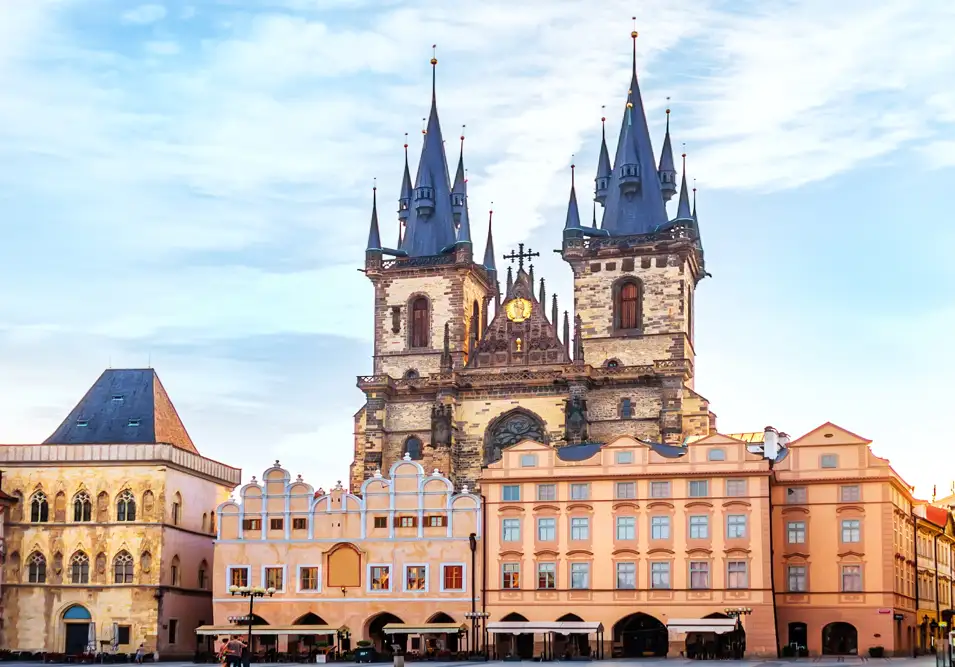
Prague
The city of Prague is indisputably the gem of Central Europe. Full of history, culture, and classic Czech pubs around every corner, Prague is teeming with nooks and crannies just waiting to be discovered. The narrow cobblestone streets and warm red rooftops give the city a homey feel, while the well-preserved medieval architecture transports you back in time. Walking across the Charles Bridge with the view of the Prague Castle will make you feel like you’re living in a fairytale, and you might as well be. As an up-and-coming destination, Prague is a perfect mix of classic and modern. New trendy cafes and bistros are always popping up, and you can always find a group of lively locals chowing down on goulash and quaffing pivo (the best beer in Europe!) at traditional Czech restaurants across the city. The clash of modernity and tradition, preservation and innovation, gives this city a mysterious air that you won’t soon forget.

Learn About Prague
Build Prague Trip

Nuremberg
One of the most authentic, storied German destinations, Nuremberg's picturesque old town, glorious castle, and buzzing Christmas Market makes this city a time-true classic. The ideal gateway to old Bavaria, Nuremberg offers a primer in German history before you embark on the lovely journey through old Bavaria, known as the Romantic Road. Considered the capital of the Holy Roman Empire in the middle ages, Nuremberg would have felt like the center of the world as a procession of kings and emperors passed through its magnificent gates. When the German Renaissance came, Nuremberg was at its heart. Albrecht Dürer, the great German master artist, was born here, and Martin Luther called Nuremberg Germany's 'eyes and ears'. Skip forward a few centuries, and the city took a dark turn, as Nuremberg became a gathering point for the German National Socialists. Slightly outside of town, you can still find the Nazi Party Rallying Grounds, a sobering reminder of the not so distant past. If it all gets too heavy, you can end the day with a glass of rotbier (red beer) and mull it over. Nuremberg is a must-see for anyone who wants to delve into Germany's past.

Learn About Nuremberg
Build Nuremberg Trip

Frankfurt
Dubbed ‘Mainhatten’ for its glass highrises, financial prowess, and proximity to the Main River, Frankfurt offers a fascinating glimpse into the ‘engine room’ of Europe’s economy with an unexpected twist. Among the glass and steel buildings, the old-worldly Römerberg square will give you a double-take. The square’s 15th-century half-timbered houses, old statues, and church spires contrast dramatically against the modern 21st-century skyscrapers beyond. If you visit at Christmas, the Römerberg is truly special, aglow with the light of the tallest Christmas tree in Germany. The square fills with stalls selling handicrafts, and the air is scented with hot apple wine, honey, and cinnamon. Delve deeper into Frankfurt and you’ll find a substantial museum district, the Museumsufer (Museum Embankment). This area features a cluster of twelve museums on either side of Main River. This includes the Städel, home to Tischbein’s famous painting of renowned writer Johann Wolfgang von Goethe, one of Frankfurt’s most prestigious sons. The more time you spend in Frankfurt, the more you’ll discover a highly cultured city lurking beneath its glass facades. If you have the time, Frankfurt is certainly worth a second look.

Learn About Frankfurt
Build Frankfurt Trip
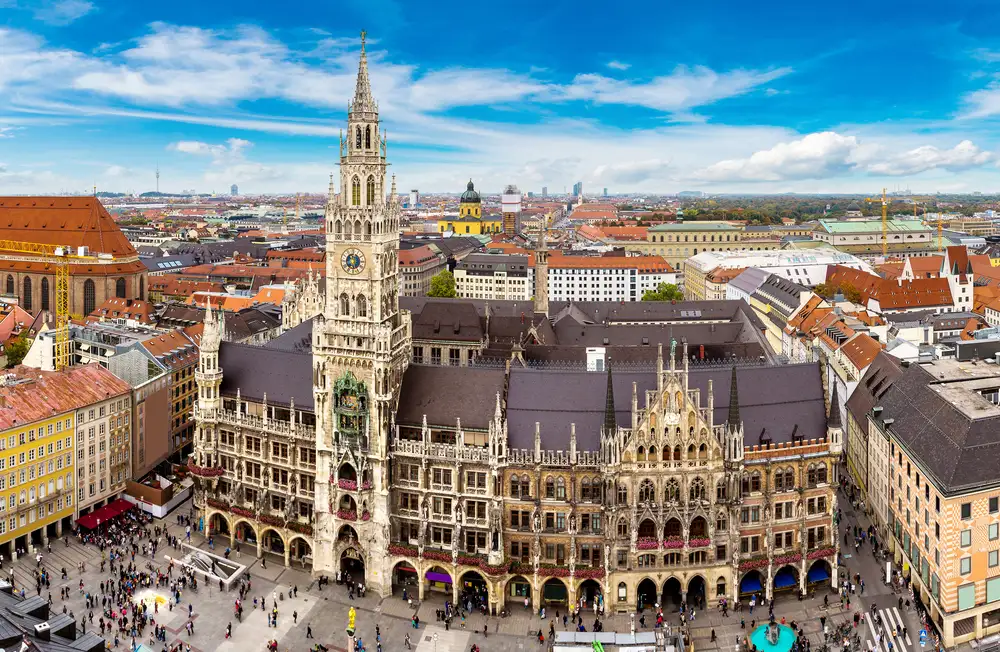
Munich
Arriving in Munich, you would be forgiven for thinking you were on the set of a movie about old Bavaria. At the Old Town beer halls, barmaids laced in dirndl dresses serve up frosty Helles lager, as oom-pah music drifts across the Marienplatz square. Men in lederhosen and checked shirts merrily give toasts as they knock glasses, or steins, as they’re known here. They sit at tables laden with wurst sausage and giant pretzels oozing with herby butter. This is Germany’s Germany, a place where folk traditions never stopped, and the revelry doesn’t either. Even when it isn’t Oktoberfest, the town’s notorious beer-drinking celebration, Munich is always happy to show you a good time. Simply cast your eyes around the lavish, gilded banquet hall at the Munich Residenz, the 13th-century Wittelsbach palace. You’ll see Munich has been impressing guests for centuries. Or, swing by the BMW Museum and check out the classic German cars. They even let you sit inside to test out the new models. At the city’s English Gardens, surfers ride waves on one of the park’s rivers. Munich is filled to the brim with this kind of pure-hearted German fun.

Learn About Munich
Build Munich Trip

Salzburg
You've probably heard this before— the city of Salzburg is straight out of a fairytale. Nestled in the mountains, this romantic city's Baroque architecture with colorful domes and spires is especially striking against the ancient fortress and Austrian Alpine backdrop. If you're looking for an amazing view, climb up to Hohensalzburg Fortress, Central Europe's largest intact fortress, for a jaw-dropping panorama of the city backed by misty mountains. Perhaps most famous for being the birthplace of the renowned composer Wolfgang Amadeus Mozart and the filming location for the classic The Sound of Music, this city has much to offer. Salzburg has become an important artistic and cultural center, featuring magnificent concert halls that uphold the city's tradition of classical music every day of the year, as well as acclaimed art exhibitions and museums. If you do it right, your visit to Salzburg will immerse you in the city's unforgettable atmosphere and keep you coming back for more.

Learn About Salzburg
Build Salzburg Trip
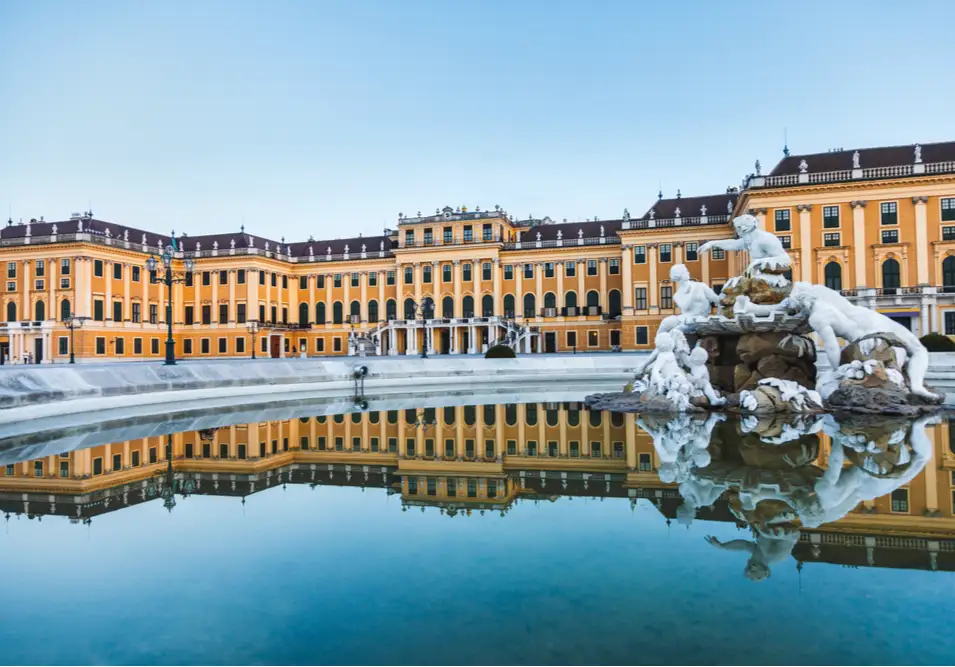
Vienna
Artistic and musical, historical and elegant, Vienna is the definition of class. The seat of the Habsburg monarchy for over six centuries, it's no wonder this city is still fit for royalty. Baroque buildings and imperial palaces dominate the cityscape, while locals stride gracefully through the streets, likely on their way to a classical music concert or art exhibition. Visitors from all over the world flock to Schonbrunn Palace, historical museums, and local eateries for authentic Viennese schnitzel. Vienna is also home to world-class wining and dining. Famous dishes include Wiener schnitzel, Tafelspitz (prime boiled beef), and apfelstrudel (apple strudel), all of which pair well with a glass of fine Austrian wine. No matter how long you spend in Vienna, you'll leave with a new appreciation for the finer things in life.

Learn About Vienna
Build Vienna Trip

Prague
The city of Prague is indisputably the gem of Central Europe. Full of history, culture, and classic Czech pubs around every corner, Prague is teeming with nooks and crannies just waiting to be discovered. The narrow cobblestone streets and warm red rooftops give the city a homey feel, while the well-preserved medieval architecture transports you back in time. Walking across the Charles Bridge with the view of the Prague Castle will make you feel like you’re living in a fairytale, and you might as well be. As an up-and-coming destination, Prague is a perfect mix of classic and modern. New trendy cafes and bistros are always popping up, and you can always find a group of lively locals chowing down on goulash and quaffing pivo (the best beer in Europe!) at traditional Czech restaurants across the city. The clash of modernity and tradition, preservation and innovation, gives this city a mysterious air that you won’t soon forget.

Learn About Prague
Build Prague Trip

Nuremberg
One of the most authentic, storied German destinations, Nuremberg's picturesque old town, glorious castle, and buzzing Christmas Market makes this city a time-true classic. The ideal gateway to old Bavaria, Nuremberg offers a primer in German history before you embark on the lovely journey through old Bavaria, known as the Romantic Road. Considered the capital of the Holy Roman Empire in the middle ages, Nuremberg would have felt like the center of the world as a procession of kings and emperors passed through its magnificent gates. When the German Renaissance came, Nuremberg was at its heart. Albrecht Dürer, the great German master artist, was born here, and Martin Luther called Nuremberg Germany's 'eyes and ears'. Skip forward a few centuries, and the city took a dark turn, as Nuremberg became a gathering point for the German National Socialists. Slightly outside of town, you can still find the Nazi Party Rallying Grounds, a sobering reminder of the not so distant past. If it all gets too heavy, you can end the day with a glass of rotbier (red beer) and mull it over. Nuremberg is a must-see for anyone who wants to delve into Germany's past.

Learn About Nuremberg
Build Nuremberg Trip

Frankfurt
Dubbed ‘Mainhatten’ for its glass highrises, financial prowess, and proximity to the Main River, Frankfurt offers a fascinating glimpse into the ‘engine room’ of Europe’s economy with an unexpected twist. Among the glass and steel buildings, the old-worldly Römerberg square will give you a double-take. The square’s 15th-century half-timbered houses, old statues, and church spires contrast dramatically against the modern 21st-century skyscrapers beyond. If you visit at Christmas, the Römerberg is truly special, aglow with the light of the tallest Christmas tree in Germany. The square fills with stalls selling handicrafts, and the air is scented with hot apple wine, honey, and cinnamon. Delve deeper into Frankfurt and you’ll find a substantial museum district, the Museumsufer (Museum Embankment). This area features a cluster of twelve museums on either side of Main River. This includes the Städel, home to Tischbein’s famous painting of renowned writer Johann Wolfgang von Goethe, one of Frankfurt’s most prestigious sons. The more time you spend in Frankfurt, the more you’ll discover a highly cultured city lurking beneath its glass facades. If you have the time, Frankfurt is certainly worth a second look.

Learn About Frankfurt
Build Frankfurt Trip

Munich
Arriving in Munich, you would be forgiven for thinking you were on the set of a movie about old Bavaria. At the Old Town beer halls, barmaids laced in dirndl dresses serve up frosty Helles lager, as oom-pah music drifts across the Marienplatz square. Men in lederhosen and checked shirts merrily give toasts as they knock glasses, or steins, as they’re known here. They sit at tables laden with wurst sausage and giant pretzels oozing with herby butter. This is Germany’s Germany, a place where folk traditions never stopped, and the revelry doesn’t either. Even when it isn’t Oktoberfest, the town’s notorious beer-drinking celebration, Munich is always happy to show you a good time. Simply cast your eyes around the lavish, gilded banquet hall at the Munich Residenz, the 13th-century Wittelsbach palace. You’ll see Munich has been impressing guests for centuries. Or, swing by the BMW Museum and check out the classic German cars. They even let you sit inside to test out the new models. At the city’s English Gardens, surfers ride waves on one of the park’s rivers. Munich is filled to the brim with this kind of pure-hearted German fun.

Learn About Munich
Build Munich Trip

Salzburg
You've probably heard this before— the city of Salzburg is straight out of a fairytale. Nestled in the mountains, this romantic city's Baroque architecture with colorful domes and spires is especially striking against the ancient fortress and Austrian Alpine backdrop. If you're looking for an amazing view, climb up to Hohensalzburg Fortress, Central Europe's largest intact fortress, for a jaw-dropping panorama of the city backed by misty mountains. Perhaps most famous for being the birthplace of the renowned composer Wolfgang Amadeus Mozart and the filming location for the classic The Sound of Music, this city has much to offer. Salzburg has become an important artistic and cultural center, featuring magnificent concert halls that uphold the city's tradition of classical music every day of the year, as well as acclaimed art exhibitions and museums. If you do it right, your visit to Salzburg will immerse you in the city's unforgettable atmosphere and keep you coming back for more.

Learn About Salzburg
Build Salzburg Trip

Vienna
Artistic and musical, historical and elegant, Vienna is the definition of class. The seat of the Habsburg monarchy for over six centuries, it's no wonder this city is still fit for royalty. Baroque buildings and imperial palaces dominate the cityscape, while locals stride gracefully through the streets, likely on their way to a classical music concert or art exhibition. Visitors from all over the world flock to Schonbrunn Palace, historical museums, and local eateries for authentic Viennese schnitzel. Vienna is also home to world-class wining and dining. Famous dishes include Wiener schnitzel, Tafelspitz (prime boiled beef), and apfelstrudel (apple strudel), all of which pair well with a glass of fine Austrian wine. No matter how long you spend in Vienna, you'll leave with a new appreciation for the finer things in life.

Learn About Vienna
Build Vienna Trip
prev
next


 Map of Your Itinerary Route
Map of Your Itinerary Route
Zoom In to the cities to see your itinerary in more detail


 4.8
4.8 






